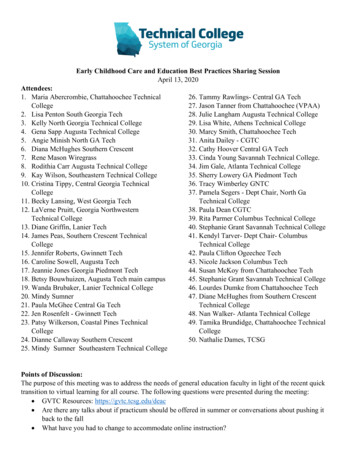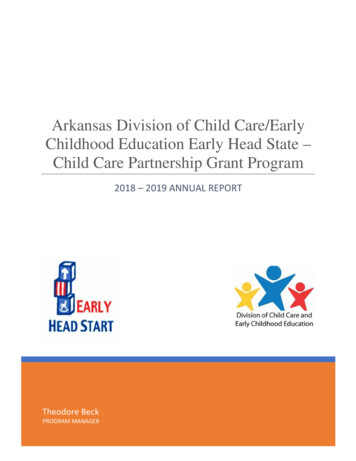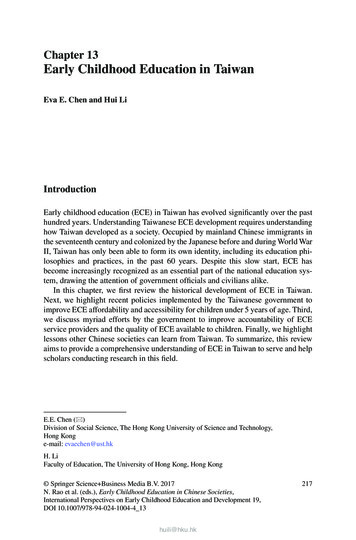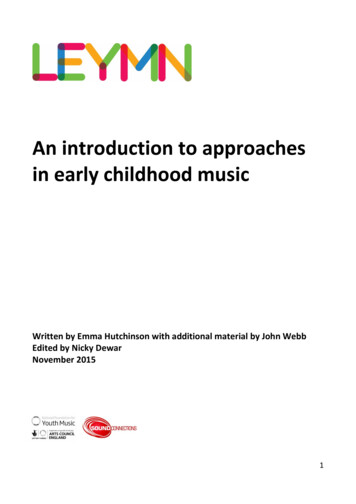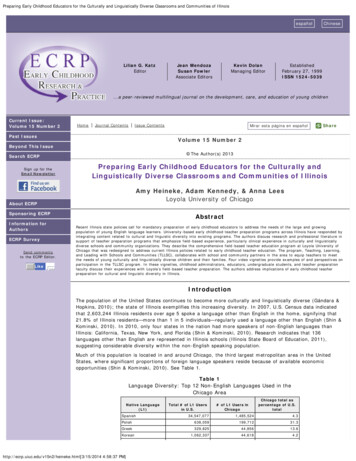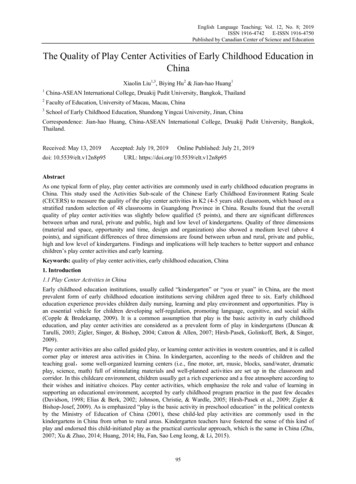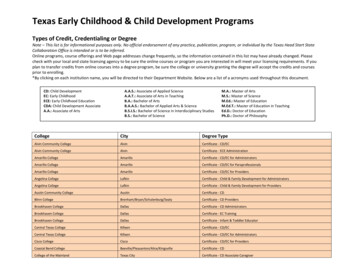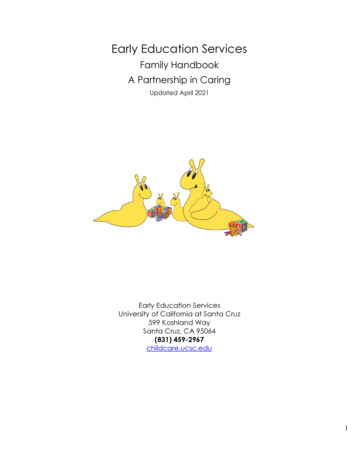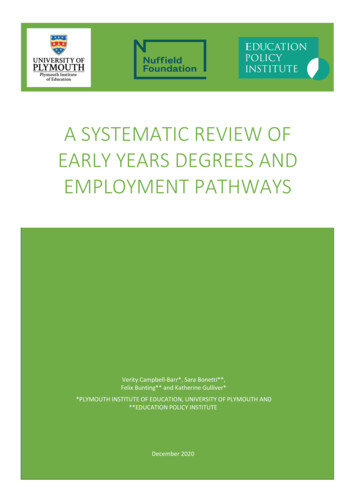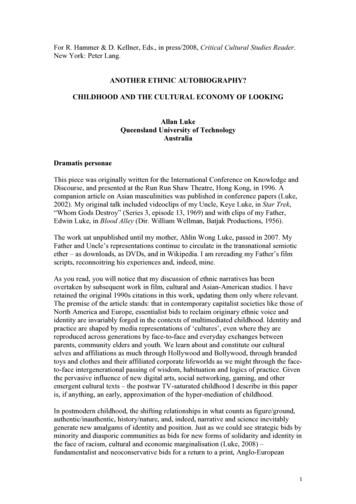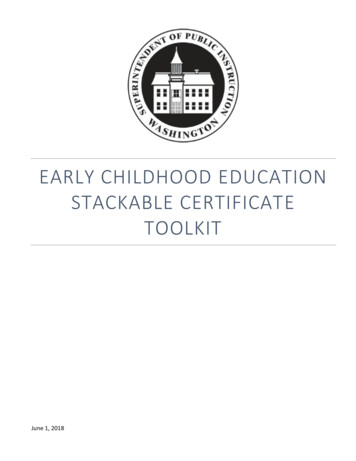
Transcription
EARLY CHILDHOOD EDUCATIONSTACKABLE CERTIFICATETOOLKITJune 1, 2018
Table of ContentsAcknowledgements . 3Washington State Stackable Certificates . 4Pathway Formation and Program of Study Forms . 6Program of Study Samples. 9Teacher Requirements. 13Career and Technical Education Teacher Requirements . 13Community and Technical College Teacher Requirements . 14General Standards of Qualifications for Community and Technical College Personnel . 14Department of Early Learning Requirements . 15Articulation Tools. 17ECED& 107: Health, Safety and Nutrition: . 18ECED& 105: Introduction to Early Childhood Education: . 22ECED& 120: Practicum . 25Resources . 30Recommended Resource Links for Outcomes and Standards . 30National standards that must be incorporated into your course frameworks. 30Outcomes and Guidelines for ECE . 30DEL Resource documents. 30EDUCATION/YVCC ECE DEPARTMENT . 31Program Policies for West Valley School District Practicum and Suggested Lessons:. 32Lessons to be Taught in ECED& 120 from YVCC: . 35Online Post Samples Used in the YVCC Practicum Class. 37Examples of Weekly Discussion assignment. 38Practicum Documentation of Hours: . 41YVCC ECED& 120 Practicum Planning Work Sheet . 42Draft ECED & 120 Competencies Self-Assessment . 49Pierce College Sample Practicum Student Evaluation . 53Page 2 of 54
AcknowledgementsThe 2012 Career and Technical Education (CTE) strategic plan recommended OSPI take the following actions: 4.2.3 Determine best and innovative practices, which may be replicated, promoted, and implemented on a largerscale. Publish results statewide.To support this goal, a committee was established to determine best practices related to stackable certificates inEarly Childhood Education (ECE) programs through Family and Consumer Science delivery. Three pilot districtsaligned their ECE curriculum with their local community college programs to meet the 15 credits achieved throughthe course work defined in the initial stackable certificate and Child Care Basics initial training requirement. Thistoolkit shares the tools and documents used to create the programs unique to each local community, and is acompendium of resources from multiple agencies, districts, and organizations. We hope it will assist other schooldistricts around Washington State to offer the ECE stackable certificate, as well.The goal of this kit is to meet the following outcomes of the 2012 CTE strategic plan: Students achieve industry-recognized certifications in alignment with benchmarks in the state PerkinsPerformance Plan (PPP).Students achieve “work-readiness” credentials in alignment with benchmarks in the state PPP.Industry and postsecondary partnerships grow in alignment with benchmarks in the state PPP.Program outcomes include portable, relevant industry-validated credentials and certifications.Statewide articulations are in place and universal between institutions.Number of credits earned at the postsecondary level through articulation agreements continues to increase.To meet these outcomes, OSPI CTE staff collaborated with community college partners for the three districts; theDepartment of Early Learning, State Board for Community and Technical Colleges, and Early Learning ProfessionalDevelopment Council; and district staff.With thanks to all members of the committee:Christopher Nesmith, Career and Technical Education Director, West Valley School DistrictDiana Anson, Family and Consumer Sciences Teacher, West Valley School DistrictKathy Adelman, Family and Consumer Sciences Teacher, Eastmont School DistrictTricia Littlefield, Family and Consumer Sciences Teacher, Sumner School DistrictRachel Aszklar, Family and Consumer Sciences Teacher, Sumner School DistrictAnna Batie, Professional Development Coordinator, Department of Early LearningMaria Joyner, Professional Development Specialist, Department of Early LearningKathy Goebel, Policy Associate, State Board for Community and Technical CollegesMelissa Matczak, Interim Director of Teacher Education, Yakima Valley CollegeNancy Spurgeon, Early Childhood Program Coordinator, Wenatchee Valley CollegeSally Holloway, Early Childhood Education Project Director, Whatcom Community CollegeMary Nagel, Family and Consumer Sciences Program Supervisor, Office of Superintendent of Public InstructionPage 3 of 54
Washington State Stackable CertificatesEarly Childhood Education (ECE) Statewide CredentialsIn Washington, early learning professionals who want to further their education have a clear path to follow. Collegesacross the state offer common courses, course titles, course numbers, course descriptions and student outcomes. Allcourses are aligned with the Washington State Core Competencies for Early Care and Education Professionals. They alsoallow students to earn “stackable” certificates: the courses that students are required to take will build on one anotherin a sequential manner and deepen levels of applied learning along the way.1) The Initial Certificate (12 credits): Students can earn this certificate as the starting point of their careers or tocontinue their professional development. The certificate focuses on competencies comparable to those of theChild Development Associate (CDA). This provides the foundation for the ECE State Certificate and associatedegree. Courses include a 5-credit Introduction to Early Childhood Education, a 5-credit Health, Safety andNutrition course, and a 2-credit practicum to apply learning.2) The ECE Short Certificate (8 credits): This certificate builds on the Initial Certificate (for a total of 20 credits). Atthis point, professionals can choose one of five specializations: ECE general, infant-toddler care, school-age care,family childcare, and ECE administration. For each specialization, students must take a 5-credit ChildDevelopment course, plus a course aligned with the specific specialization.3) The ECE State Certificate (27-32 credits): This final “stackable certificate” requires college-level math andEnglish as a foundation for the next step: an associate degree in ECE. In addition to these general educationrequirements, the courses that students must take include Language and Literacy Development; Observationand Assessment; Child, Family and Community; Guiding Behavior; Environments for Young Children; andCurriculum Development. With all three certificates, the total number of credits earned by the student is 47-52.The colleges vary in the number of required credits for some classes. A class at one college may be 3 credits,while at another the same course is 5 credits.Page 4 of 54
WASHINGTON ST A TTEE ST A CCK ABLE CTIFICATESWASHIGTOSTSTABLECE RRTIFICATESInitial ECECertificateShort ECE Certificate ofSpecialization12 credits8 ��5 credits: Intro to EarlyChildhood Education(ECED& 105)State Initial ECE Certificate, plus one of thefollowing specializations:State Initial and State Short ECECertificates, plus the following:Early Childhood Education (General)5 credits: Child Development (EDUC& 115)3 credits: Guiding Behavior (EDUC& 130)5 credits: English 100, 101, orabove5 credits: Health,Safety, Nutrition(ECED& 107)2 credits: Practicum:Focus onRelationships &Communication(ECED& 120)27-32 credits– OR –Infant / Toddler Care5 credits: Child Development (EDUC& 115)3 credits: Infant/Toddler Care (ECED& 132)– OR –School-age Care5 credits: Child Development (EDUC& 115)3 credits: School-age Care (EDUC& 136)– OR –Family Child Care5 credits: Child Development (EDUC& 115)3 credits: Family Child Care (ECED& 134)– OR –Administration5 credits: Child Development (EDUC& 115)3 credits: Admin Early Learning (ECED&139)12 creditsECE Certificate 8 credits 20 credits total5 credits: Math (quantitative orcomputational math above 100or designated “Q/SR”)3 credits: Child/Family/Community (EDUC& 150)3 credits: Language/LiteracyDevelop (ECED& 180)3 credits: Observation andAssessment (ECED& 190)5 credits: CurriculumDevelopment (ECED& 160)Choose one:3 credits: Environments, YoungChild (ECED& 170)– OR –3 credits: Guiding Behavior(EDUC& 130) 27-32 credits 47-52 creditstotalThe diagram above summarizes the three certificates and required coursework. Contact your local community ortechnical college for details about course offerings. For more information about stackable certificates, please visitthe Department of Early Learning, at our-early-learning-career.Page 5 of 54
Pathway Formation and Program of Study FormsThe U.S. Bureau of Labor Statistics projects that day care businesses will have some of the fastest employment growth ofall industries through 2020, and, according to new data from Sageworks, child day care businesses in the U.S. haveconsistently grown sales in recent years, even as many other industries struggled in the economic recession andsubsequent recovery. 1Creating a pathway for students could lead to filling those needs in the local community. When looking at forming thistype of program, the school district must have a partnership for the required practicum component. The school districtshould evaluate its local community to determine appropriate partnerships. This may be achieved through a variety ofmethods. An onsite pre-school or childcare center, in cooperation with a Graduation, Reality and Dual-Role Skills (GRADS)program, which may offer services to students, staff, and community members. The district may choose tocontract with Early Childhood Education and Assistance Program (ECEAP), Head Start, or private contractors torun the program. The program could use school district elementary programs such as the special education pre-school, ECEAP, orHead Start programs run by the district. Early Learning is defined as birth to age eight. Therefore, classrooms upto the third grade would be appropriate placements. Offsite private programs connecting with community centers allow students internship opportunities.Three site location partnerships participated in the toolkit development: Eastmont School District and Wenatchee Valley Community College Sumner School District including both Bonney Lake and Sumner High Schools, and Pierce College West Valley Yakima School District and Yakima Valley Community CollegeEach school district involved utilizes a different method for practicum placement. Eastmont School District has an onsite Special Education program on both sides of the Family and ConsumerSciences (FACS) classroom. This allows observation of children from the FACS classroom, as well as practicumplacement in the center. Sumner School District has onsite preschool and childcare centers that serve students, district staff, andcommunity children. Students are also able to observe and serve their practicum onsite. West Valley Yakima School District has an onsite center, but collaborates with nearby district elementaryschools. This includes district ECEAP programs.The next few pages include the OSPI and SBCTC steps to take to create a pathway. Program of Study sampledocuments demonstrate the steps used by each program to create an ECE pathway.1Monthly Labor Review, January 2012: Industry employment and output projections to 2020Page 6 of 54
for Identifying a Program ofStudy In Preparation for ApprovalSBCTC. , ., . '""''"". ! f ' - ('.( MM Nl'I &. 'tC.-.C.-. f:'.). J;(-!1. When a Cluste r or Pat hway has been identified, the groundwork is there for the Program of Studyto be developed.2. Ident ify and collaborate with t he local Program of Study contact at the post secondary level and theCTE Director at t he secondary level to begin designing th e Program of St udy.3. Begin by com pleting t he Program of Study t emplate4. Select the appropriat e t emplate for reference based on one of the 16 Career Clust ers.5. Secondary partners fi ll in t he:a. Required core courses for graduation, as defined by t he district or high school in t heappro priat e year (9-12 grades) at th e secondary level.b. Fill in the concentration of CTE cou rses the dist rict or high school offers that align with t heparticular Program of St udy.c. Fill in the relat ed academic courses t hat are recommended to prepare a stud ent for entryinto t he postsecondary portion of t he Program of Study.6. At t he postsecondary level, fi ll in the courses required for degree or certificat e completion.7. Make sure t hat at least the minimum criteria have been met, as outl ined in t he att ached Programof St udy Assurances page.8. Highlight the courses where there is an articulation agreement for dual credit This will helpdetermine post secondary alignment.9. Once t his template is complet e t he Program of Study Assurances should be signed by t he secondaryCTE direct or, the postsecondary institut ion' s Workforce Dean, and t he appro priat e Program ofStudy Contacts.10. Th e completed and signed Assu rances form will be held on file by the secondary and post secondarycontact s. Programs of Study on fi le will be included in t he secondary and postsecondary ann ualPerkins plan, and will be reviewed during CPR (Secondary) and Perkins Monitoring (Post secondary).Page 7 of 54
Program of Study AssurancesSBCTC. , ., . '""''"". ! f' - ('.( MM Nl'I &. 'tC.-.C.-. f:'.). J;(-!Minimum CriteriaDTh e secondary CTE, academic, and appropriate elective cou rses are included, as well as thest at e and loca l graduation requirements.DDTh e secondary Program of Study includes leadersh ip standards, through 21 st Centu ry skills.Th e Program of Stu dy includes coherent and rigorous coursework in a non-duplicative sequenceof courses from secondary t o postsecondary.DCompletion of th e secondary Program of Study prepares st udents for entry into thepost secondary opportuniti es (milita ry, employment, apprenticeship, certificat e and/ or degreeprograms) .DDProgram of Study courses include appropriate state st andards and/ or ind ust ry skills st andards.Program of Study leads to an industry recognized credential; academic certificat e or degree; ore mployment.DMay include dual enrollment/ cred it opportunity wh ich may incl ude a dual cred it articulationagreement wh ich th e district has on file for one or more courses in t heseconda ry/post secondary Program of St udy.Exceeds Minimum CriteriaDDTh e Program of Stu dy incl udes mult iple entry and/ or exit points at t he post-secondary level.Th e Program of Stu dy offers course work and skill development for self-employment and/ore nt repreneu rial opportun ities.DTh e Program of St udy is linked to a com prehensive school cou nseling program, such as Ca reerGuidance Washington.DTh ere is program alignment bet ween t he commu nity and technica l college Program of Study anda baccala ureat e program, with a signed articulation agreement on file.Req uired Signat ures (all districts and in stitut ions participati ng in th e development an d offering ofthe program of study). Add additional lines as needed.Secondary Institution Name:CTE Director o r Designee Name:Signature: Dat e :Postsecondary Institution Name:Workforce Dean Name:-------------------------Signature: - - - - - - - - - - - - - - - - - - - - Dat e :Program of Study Cont act Name:Sigm::1 lur ;0 1l t,;Page 8 of 54
Program of Study SamplesThe following samples belong to Sumner School District and Eastmont School District. A link to West Valley SchoolDistrict can also be found below.PROGRAM OF STUDY: West Valley School DistrictCluster: Human ServicesPathway: Early Childhood Development and ServicesThis Early Childhood Development and Services Program of Study can serve as a guide along withother career planning materials as learners continue on a career path. Courses listed within thisprogram are only recommended coursework and should be individualized to meet each learner’seducation and career goals. The program of study as outlined below allows students to earncollege credit while completing course work within West Valley High School through the TechPrep Program and apply those credits towards attainment of a college certificate and/or degree.As with high school planning, it is important to share and review your plan with aparent/guardian and school counselor.To view the West Valley School District Program of Study, follow the link Server cation%20D.PDFPage 9 of 54
eNwesPROGRAM OF STUDY: Sumner School DistrictCluster: Human ServicesPathway: Early Childhood Development and ServicesThis Program of Study, along with other career planning materials, can serve as a guide as learners continueon a career path. Courses listed are only recommended and plans should be individualized to meet eachlearner's educational and career goals. Students should recognize tha
With all three certificates, the total number of credits earned by the student is 47-52. The colleges vary in the number of required credits for some classes. A class at one college may be 3 credits, . Sumner School District including both Bonney Lake and
